人教版高二英语选修7Unit 4 Sharing Grammar课件(38张)
文档属性
| 名称 | 人教版高二英语选修7Unit 4 Sharing Grammar课件(38张) |  | |
| 格式 | zip | ||
| 文件大小 | 1.2MB | ||
| 资源类型 | 教案 | ||
| 版本资源 | 人教版(新课程标准) | ||
| 科目 | 英语 | ||
| 更新时间 | 2020-02-17 17:28:53 | ||
图片预览


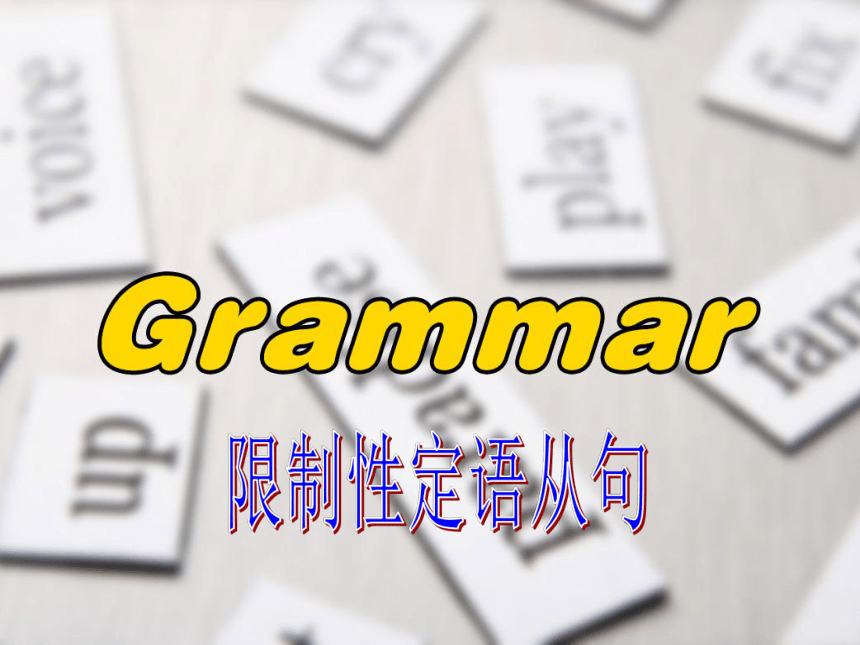
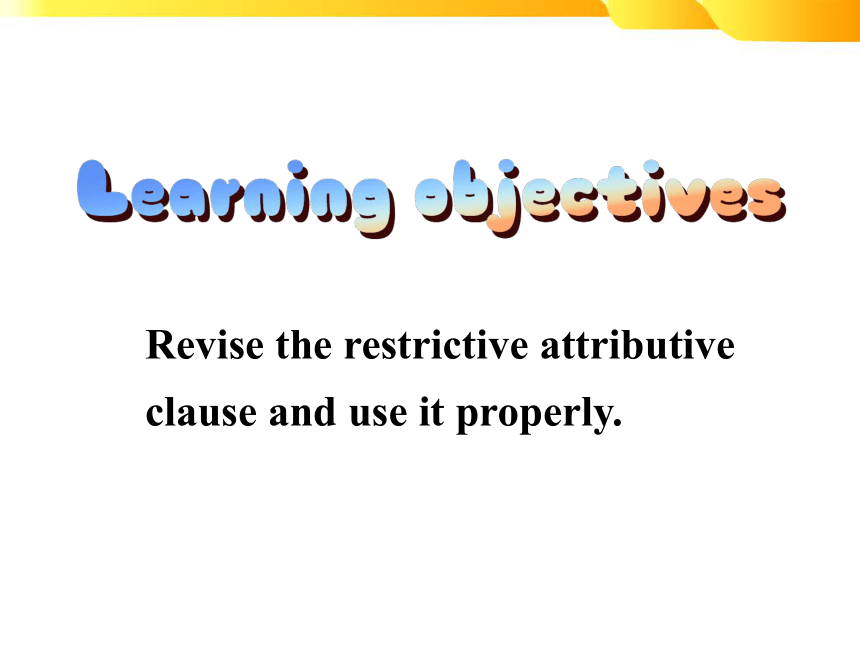
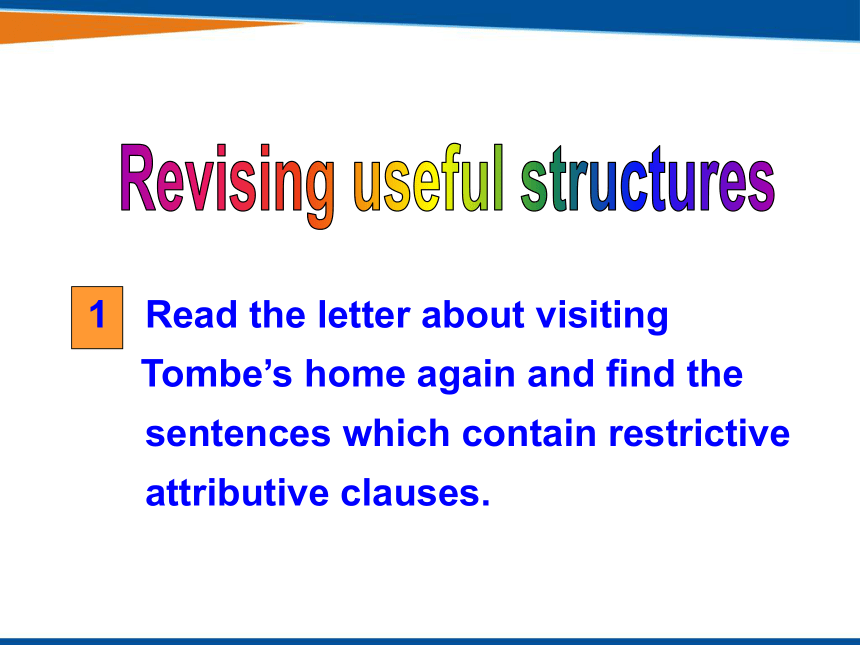
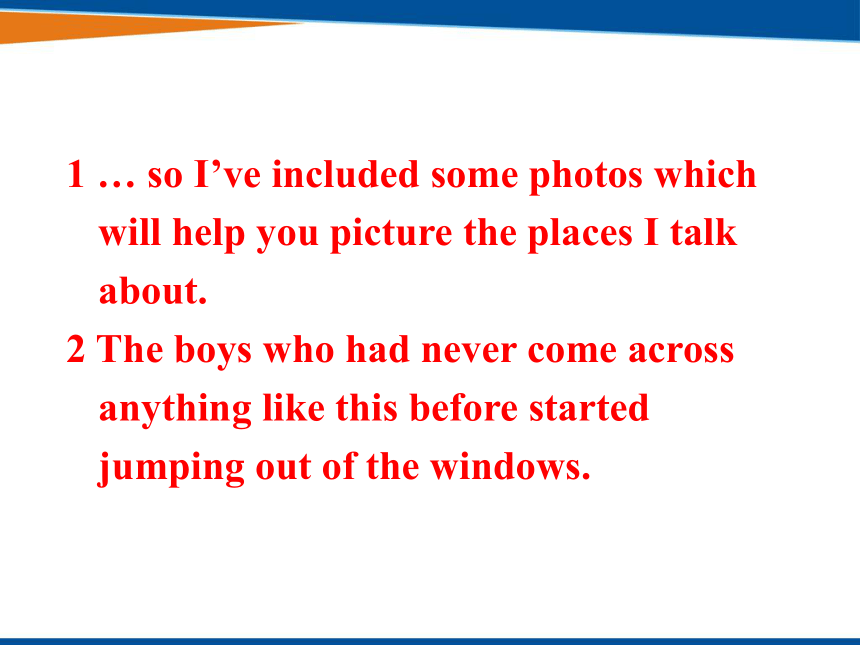

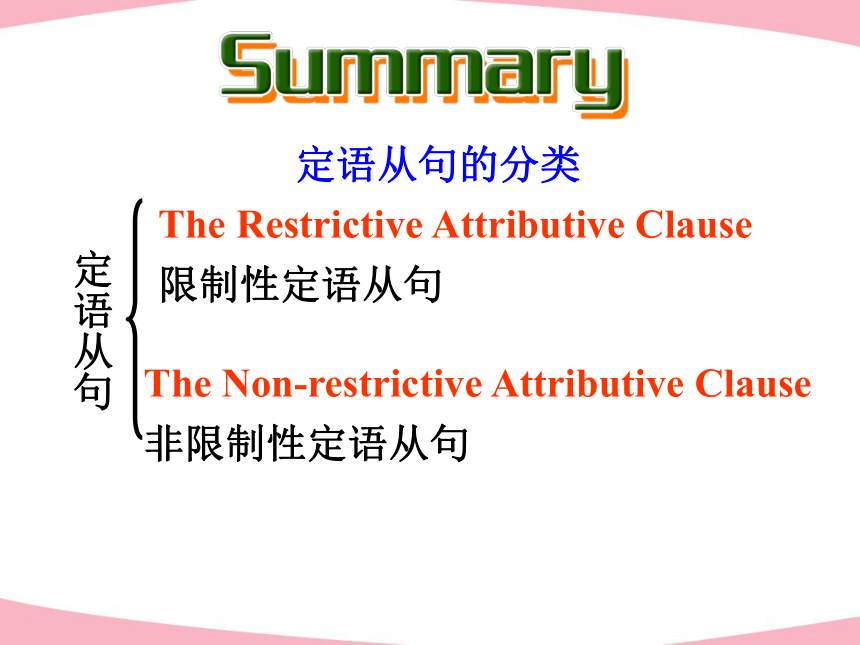
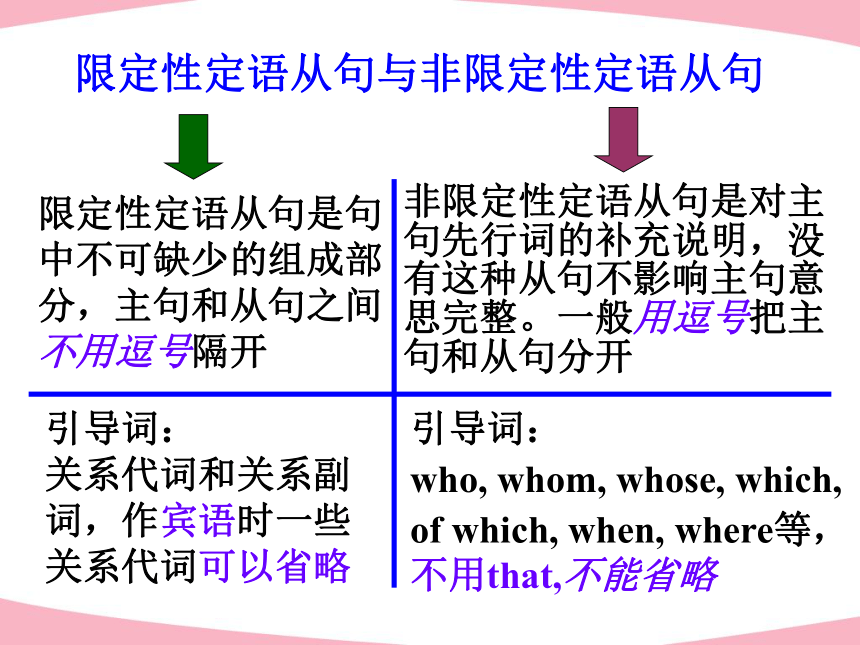
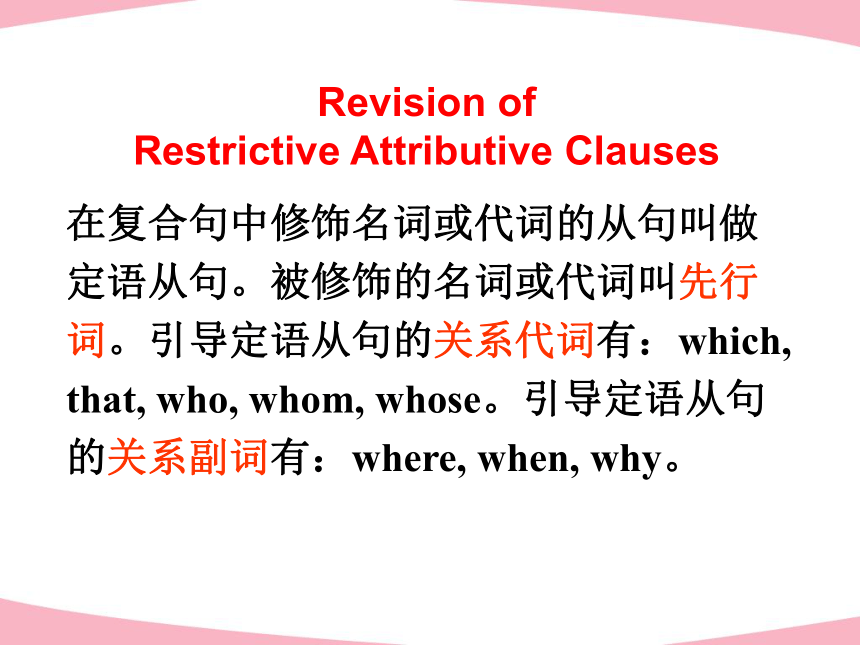
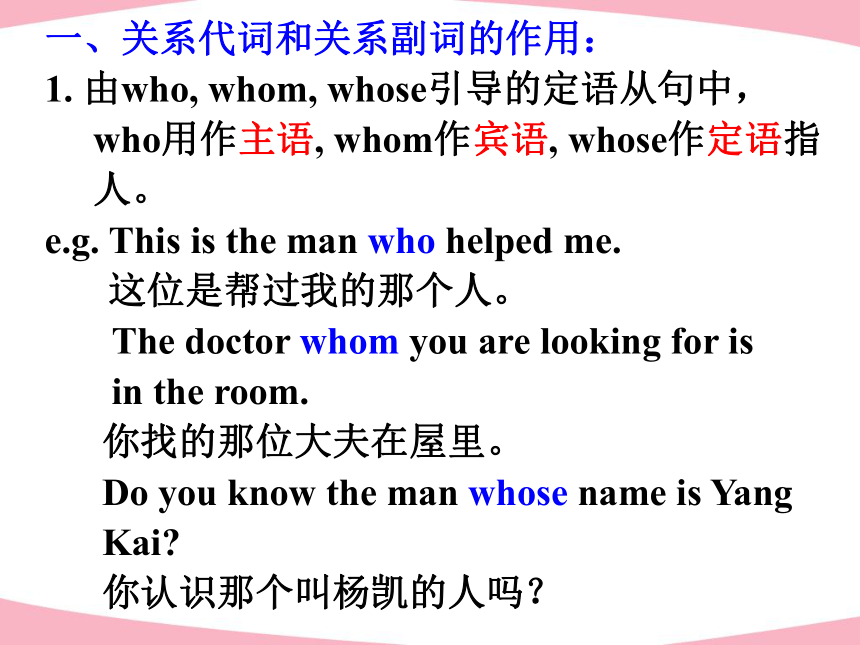
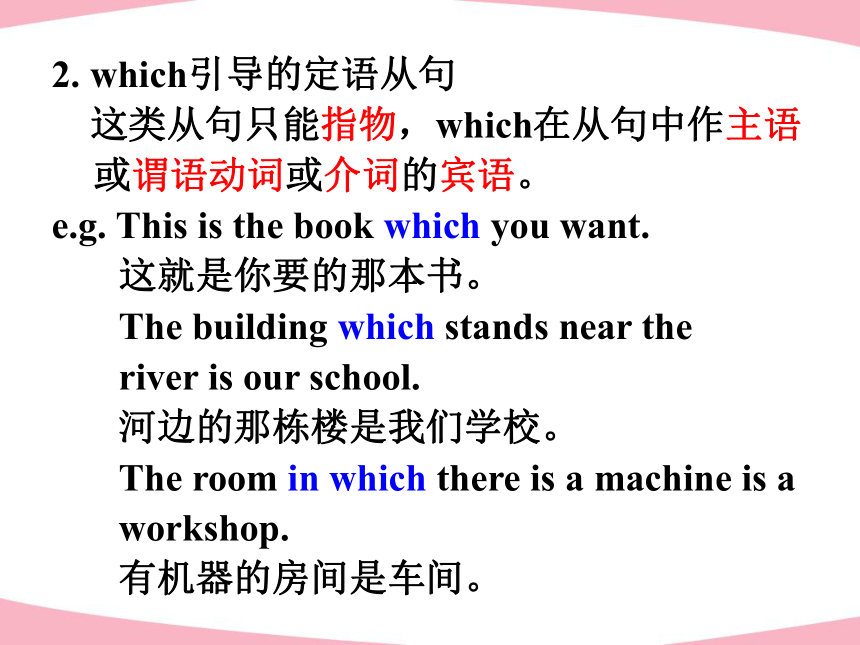
文档简介
课件38张PPT。Unit 4Unit 4
Sharing限制性定语从句Revise the restrictive attributive clause and use it properly.Revising useful structuresRead the letter about visiting
Tombe’s home again and find the sentences which contain restrictive attributive clauses.1 … so I’ve included some photos which will help you picture the places I talk about.
2 The boys who had never come across anything like this before started jumping out of the windows.3 … and I did visit a village which is the home of one of the boys …
4 … first up a mountain to a ridge from where we had fantastic views …
5 The only possessions I could see were one broom …定语从句的分类定语从句The Restrictive Attributive Clause
限制性定语从句The Non-restrictive Attributive Clause
非限制性定语从句限定性定语从句与非限定性定语从句限定性定语从句是句中不可缺少的组成部分,主句和从句之间不用逗号隔开非限定性定语从句是对主句先行词的补充说明,没有这种从句不影响主句意思完整。一般用逗号把主句和从句分开引导词:
who, whom, whose, which,
of which, when, where等,不用that,不能省略引导词: 关系代词和关系副词,作宾语时一些关系代词可以省略Revision of
Restrictive Attributive Clauses在复合句中修饰名词或代词的从句叫做定语从句。被修饰的名词或代词叫先行词。引导定语从句的关系代词有:which, that, who, whom, whose。引导定语从句的关系副词有:where, when, why。一、关系代词和关系副词的作用:
1. 由who, whom, whose引导的定语从句中,who用作主语, whom作宾语, whose作定语指人。
e.g. This is the man who helped me.
这位是帮过我的那个人。
The doctor whom you are looking for is
in the room.
你找的那位大夫在屋里。
Do you know the man whose name is Yang
Kai?
你认识那个叫杨凯的人吗?2. which引导的定语从句
这类从句只能指物,which在从句中作主语或谓语动词或介词的宾语。
e.g. This is the book which you want.
这就是你要的那本书。
The building which stands near the
river is our school.
河边的那栋楼是我们学校。
The room in which there is a machine is a
workshop.
有机器的房间是车间。注:
whom,which作介词宾语时, 介词一
般可放在它们之前, 也可放
在从句原来的位置上, 在含有介词的
动词固定词组中, 介词只能放在原来的
位置上。
e.g. This is the person whom you are
looking for.
这位就是你在找的那个人。3. 由that引导的定语从句
that在定语从句中可以指人或物, 在从句
中作主语或谓语动词的宾语。但不能放在
介词后面作介词宾语。
e.g. The letter that I received was from my
father.
我收到的那封信是我父亲写给我的。
The man that is making a speech looks like
Jenny’s father.
正在做演讲的那个人看起来像詹妮的爸
爸。在下面几种情况下必须用“that”引导定语从句:
1) 先行词是不定代词: all, few, little,
much, something, nothing, anything
等。
e.g. All that we have to do is to practice
every day.
我们要做的就是每天练习。注意:2) 先行词被序数词或形容词最高级所修饰。
e.g. The first lesson that I learned in
high school will never be forgotten.
我永远也不会忘记我在高中上的第
一节课。3) 先行词被all, any, every, each, few, little, no, some等修饰。
e.g. I have read all the books (that) you
gave me.
你给我的书我全读完了。4) 先行词被the only, the very, the last修
饰时。
e.g. He is the only person that I want to
talk to.
他是唯一的我想说话的人。5) 先行词既有人又有物时。
e.g. They talked of things and persons
that they remembered in the school.
他们谈论着他们能记起的那些在学
校的人和事。4. 由when, where, why引导的定语从句。
e.g. I know the reason why he came late.
我知道他为什么来晚了。
This is the place where we lived for 5
years.
这就是我住过五年的地方。 I will never forget the day when I met Mr. Li.
我永远也忘不了遇到李先生的那天。先行词是表示地点时, 有时用 _______,有时用 ___________引导定语从句。这时要看从句的谓语动词是及物动词还是不及物动词。如果是及物动词就用that (which), 否则用where。 wherethat (which)e.g. This is the house where he lived
last year.
这就是我去年住的房子。
This is the house that (which) he
visited last year.
这就是我去年去过的房子。5. 由as引导的定语从句
as可作为__________和__________来引导定语从句。
1) such … as… 像……一样的,
像……之类
the same … as … 和……同样的关系代词关系副词 在这两个句型中, as是关系代词, 其中such, same作定语, 修饰主句的名词、代词, 这个名词是这个定语从句的先行词, as在从句中担任主、宾、表。
e.g. This is the same thing as we are in need
of.
这和我们需要的一样。
I’ve?never heard such stories as he told.
我从未听过他讲的那样的故事。 2) … such as …
such为代词,意思为 “这样的人/物”,as修饰先行词such。
e.g. This book is not such as I hope.
这本书不是我希望的那样。3) the same … as …/the same … that …
as,that都引导定语从句。意思几乎
相同。但从句中省去谓语必须用as。
e.g. She is the same age as you/that you
are.
她和你同龄。三、注意事项:关系代词和关系副词在定语从句中的不同成分。
a. This is the place where he works.
这是他工作的地方。
This is the place which (that) we visited
last year.
这是我们去年参观过的地方。b. That was the time when he arrived.
那是他到达的时间。
Do you still remember the days that (which) we spent together?
你还记得我们在一起度过的那些日子吗?c. This is the reason why he went.
这是他为什么去的原因。
The reason that (which) he gave us
was quite reasonable.
他给我们的理由很合理。 1. What kind of friend would you like to have?
(whom)
2. What kind of place would you like to go for a
holiday? (where)
3. What story do you enjoy most? (which/ that)
4. Which musical instrument would you like to
learn to play? (which/ that)
5. Why didn’t you finish your homework? (why)Answer the questions using attribute clauses with the pronouns in brackets. Compare your answers with your partner. 6. What kind of person is she married to? (to
whom)
7. What sport do you participate in most often?
(which/ that)
8. Which day won’t you ever forget? (when)broom jar tin textbook roof grill
interpreter weed rectangleWork in pairs. One student defines one word in the box with the attribute clause. The other students guesses the word. Then take turns. EXAMPLES1: I’m thinking of a shape which has
four straight side of different
lengths with four 90°angles.
S2: Is it a rectangle?
S1: Yes, it is. …用适当的关系词完成短文填空。
At the age of nine, Eva Hoffman left Poland with her family. She was old enough to know what she was losing: Gracow, a city 1. __________ she loved as one loves a person, the sun-baked villages 2. ________ they had taken summer vacations, and the conversations and escapades (恶作剧) with her friends. Disconnected from a city in 3. ______ life was lived intensely, which/ thatwhere whichher father would become overwhelmed (不知所措的) by the transition to Canada. Eva would lose the parent 4. ________________ she had watched in lively conversation with friends in Cracow cafés. And nothing could replace her friendship with the boy 5. ______ home she visited daily and 6. ___________ she assumed she would someday marry. Worst of all, she would miss her language. who / that / whomwhose whom / who For years, she would feel no connection to the English name of anything 7. ________ she felt was important. Lost in Translation: A Life in a New Language (New York: Penguin, 1989) tells how Eva came to terms with her new identity and language. It’s a story 8. ____________ readers will find fascinating and moving. thatthat / which Finish exercise 2 with your own words.
Sharing限制性定语从句Revise the restrictive attributive clause and use it properly.Revising useful structuresRead the letter about visiting
Tombe’s home again and find the sentences which contain restrictive attributive clauses.1 … so I’ve included some photos which will help you picture the places I talk about.
2 The boys who had never come across anything like this before started jumping out of the windows.3 … and I did visit a village which is the home of one of the boys …
4 … first up a mountain to a ridge from where we had fantastic views …
5 The only possessions I could see were one broom …定语从句的分类定语从句The Restrictive Attributive Clause
限制性定语从句The Non-restrictive Attributive Clause
非限制性定语从句限定性定语从句与非限定性定语从句限定性定语从句是句中不可缺少的组成部分,主句和从句之间不用逗号隔开非限定性定语从句是对主句先行词的补充说明,没有这种从句不影响主句意思完整。一般用逗号把主句和从句分开引导词:
who, whom, whose, which,
of which, when, where等,不用that,不能省略引导词: 关系代词和关系副词,作宾语时一些关系代词可以省略Revision of
Restrictive Attributive Clauses在复合句中修饰名词或代词的从句叫做定语从句。被修饰的名词或代词叫先行词。引导定语从句的关系代词有:which, that, who, whom, whose。引导定语从句的关系副词有:where, when, why。一、关系代词和关系副词的作用:
1. 由who, whom, whose引导的定语从句中,who用作主语, whom作宾语, whose作定语指人。
e.g. This is the man who helped me.
这位是帮过我的那个人。
The doctor whom you are looking for is
in the room.
你找的那位大夫在屋里。
Do you know the man whose name is Yang
Kai?
你认识那个叫杨凯的人吗?2. which引导的定语从句
这类从句只能指物,which在从句中作主语或谓语动词或介词的宾语。
e.g. This is the book which you want.
这就是你要的那本书。
The building which stands near the
river is our school.
河边的那栋楼是我们学校。
The room in which there is a machine is a
workshop.
有机器的房间是车间。注:
whom,which作介词宾语时, 介词一
般可放在它们之前, 也可放
在从句原来的位置上, 在含有介词的
动词固定词组中, 介词只能放在原来的
位置上。
e.g. This is the person whom you are
looking for.
这位就是你在找的那个人。3. 由that引导的定语从句
that在定语从句中可以指人或物, 在从句
中作主语或谓语动词的宾语。但不能放在
介词后面作介词宾语。
e.g. The letter that I received was from my
father.
我收到的那封信是我父亲写给我的。
The man that is making a speech looks like
Jenny’s father.
正在做演讲的那个人看起来像詹妮的爸
爸。在下面几种情况下必须用“that”引导定语从句:
1) 先行词是不定代词: all, few, little,
much, something, nothing, anything
等。
e.g. All that we have to do is to practice
every day.
我们要做的就是每天练习。注意:2) 先行词被序数词或形容词最高级所修饰。
e.g. The first lesson that I learned in
high school will never be forgotten.
我永远也不会忘记我在高中上的第
一节课。3) 先行词被all, any, every, each, few, little, no, some等修饰。
e.g. I have read all the books (that) you
gave me.
你给我的书我全读完了。4) 先行词被the only, the very, the last修
饰时。
e.g. He is the only person that I want to
talk to.
他是唯一的我想说话的人。5) 先行词既有人又有物时。
e.g. They talked of things and persons
that they remembered in the school.
他们谈论着他们能记起的那些在学
校的人和事。4. 由when, where, why引导的定语从句。
e.g. I know the reason why he came late.
我知道他为什么来晚了。
This is the place where we lived for 5
years.
这就是我住过五年的地方。 I will never forget the day when I met Mr. Li.
我永远也忘不了遇到李先生的那天。先行词是表示地点时, 有时用 _______,有时用 ___________引导定语从句。这时要看从句的谓语动词是及物动词还是不及物动词。如果是及物动词就用that (which), 否则用where。 wherethat (which)e.g. This is the house where he lived
last year.
这就是我去年住的房子。
This is the house that (which) he
visited last year.
这就是我去年去过的房子。5. 由as引导的定语从句
as可作为__________和__________来引导定语从句。
1) such … as… 像……一样的,
像……之类
the same … as … 和……同样的关系代词关系副词 在这两个句型中, as是关系代词, 其中such, same作定语, 修饰主句的名词、代词, 这个名词是这个定语从句的先行词, as在从句中担任主、宾、表。
e.g. This is the same thing as we are in need
of.
这和我们需要的一样。
I’ve?never heard such stories as he told.
我从未听过他讲的那样的故事。 2) … such as …
such为代词,意思为 “这样的人/物”,as修饰先行词such。
e.g. This book is not such as I hope.
这本书不是我希望的那样。3) the same … as …/the same … that …
as,that都引导定语从句。意思几乎
相同。但从句中省去谓语必须用as。
e.g. She is the same age as you/that you
are.
她和你同龄。三、注意事项:关系代词和关系副词在定语从句中的不同成分。
a. This is the place where he works.
这是他工作的地方。
This is the place which (that) we visited
last year.
这是我们去年参观过的地方。b. That was the time when he arrived.
那是他到达的时间。
Do you still remember the days that (which) we spent together?
你还记得我们在一起度过的那些日子吗?c. This is the reason why he went.
这是他为什么去的原因。
The reason that (which) he gave us
was quite reasonable.
他给我们的理由很合理。 1. What kind of friend would you like to have?
(whom)
2. What kind of place would you like to go for a
holiday? (where)
3. What story do you enjoy most? (which/ that)
4. Which musical instrument would you like to
learn to play? (which/ that)
5. Why didn’t you finish your homework? (why)Answer the questions using attribute clauses with the pronouns in brackets. Compare your answers with your partner. 6. What kind of person is she married to? (to
whom)
7. What sport do you participate in most often?
(which/ that)
8. Which day won’t you ever forget? (when)broom jar tin textbook roof grill
interpreter weed rectangleWork in pairs. One student defines one word in the box with the attribute clause. The other students guesses the word. Then take turns. EXAMPLES1: I’m thinking of a shape which has
four straight side of different
lengths with four 90°angles.
S2: Is it a rectangle?
S1: Yes, it is. …用适当的关系词完成短文填空。
At the age of nine, Eva Hoffman left Poland with her family. She was old enough to know what she was losing: Gracow, a city 1. __________ she loved as one loves a person, the sun-baked villages 2. ________ they had taken summer vacations, and the conversations and escapades (恶作剧) with her friends. Disconnected from a city in 3. ______ life was lived intensely, which/ thatwhere whichher father would become overwhelmed (不知所措的) by the transition to Canada. Eva would lose the parent 4. ________________ she had watched in lively conversation with friends in Cracow cafés. And nothing could replace her friendship with the boy 5. ______ home she visited daily and 6. ___________ she assumed she would someday marry. Worst of all, she would miss her language. who / that / whomwhose whom / who For years, she would feel no connection to the English name of anything 7. ________ she felt was important. Lost in Translation: A Life in a New Language (New York: Penguin, 1989) tells how Eva came to terms with her new identity and language. It’s a story 8. ____________ readers will find fascinating and moving. thatthat / which Finish exercise 2 with your own words.
